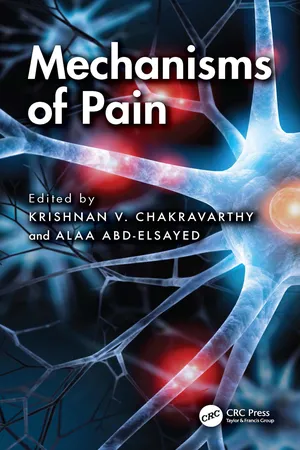
- English
- ePUB (mobile friendly)
- Available on iOS & Android
Mechanisms of Pain
About this book
Pain is a serious health problem. This book presents an intensive review of the anatomy, physiology, and pharmacology of the systems that mediate nociceptive processing. The authors cover areas that include anatomy, central and peripheral nerve processing, tissue and nerve injury states, as well as preclinical and clinical models of pain. Mechanisms of Pain also covers important clinical concepts, with specific emphasis on mechanisms of action. Written by world renowned global faculty, this book covers important areas of science required to understand pain medicine. Important topics covered include post–tissue and nerve injury pain states of primary afferents and the spinal cord. The authors also cover mechanisms of action of clinically relevant analgesics (opiates and non-opiates), psychological aspects of pain, pathophysiology of migraines, as well as the genetics of pain. This comprehensive book is to guide undergraduate, graduate, and clinicians in the field of pain medicine on important concepts related to the science and practice of pain.
Frequently asked questions
- Essential is ideal for learners and professionals who enjoy exploring a wide range of subjects. Access the Essential Library with 800,000+ trusted titles and best-sellers across business, personal growth, and the humanities. Includes unlimited reading time and Standard Read Aloud voice.
- Complete: Perfect for advanced learners and researchers needing full, unrestricted access. Unlock 1.4M+ books across hundreds of subjects, including academic and specialized titles. The Complete Plan also includes advanced features like Premium Read Aloud and Research Assistant.
Please note we cannot support devices running on iOS 13 and Android 7 or earlier. Learn more about using the app.
Information
Table of contents
- Cover
- Half Title
- Title
- Copyright
- Contents
- About the Editors
- List of Contributors
- Chapter 1 Pain: Introductory and Key Concepts in the Basis of Pain
- Chapter 2 Organization of the Nervous System: Gross Anatomy
- Chapter 3 Neurophysiology of Pain—Peripheral
- Chapter 4 DRG/Peripheral Nerve: Multicellular Modality and Coding
- Chapter 5 Peripheral Nerve and Dorsal Root Ganglion (DRG) Pharmacology: Mechanisms, Therapeutic Targets, and Clinical Applications
- Chapter 6 Dorsal Horn Organization and Processing
- Chapter 7 The Psychophysiology of Pain
- Chapter 8 Post–Tissue Injury Pain State: Primary Afferent
- Chapter 9 Post–Tissue Injury Pain State: Spinal Cord
- Chapter 10 Post–Nerve Injury Pain States: Primary Afferent
- Chapter 11 Post–Nerve Injury Pain States: Spinal Cord
- Chapter 12 Visceral Pain System/Neuro-Immune Interaction
- Chapter 13 Preclinical Models of Pain
- Chapter 14 Human Experimental Pain Models: Clinical Applications and Molecular Mechanisms in Drug Development
- Chapter 15 Psychological Aspects of Pain: A Focus on Depression
- Chapter 16 Neuromodulation
- Chapter 17 Mechanisms of Action of Clinically Relevant Analgesics (Opioids)
- Chapter 18 Mechanisms of Action of Clinically Relevant Analgesics (Non-Opiates)
- Chapter 19 Pathophysiology of Migraine
- Chapter 20 Genetics of Pain
- Chapter 21 Chronic Lower Back Pain: Etiology and Treatment
- Index